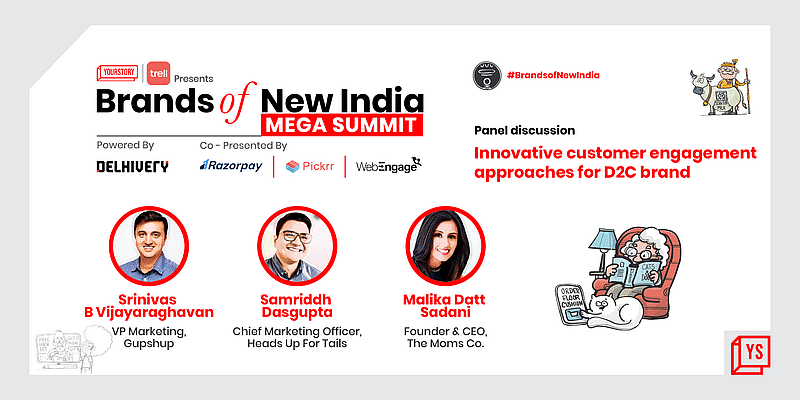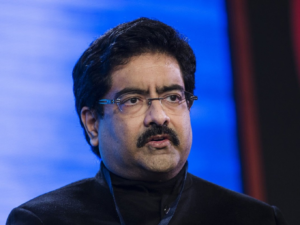Cracking the code for quality customer engagement is one of the key elements in building a successful D2C business. But, in a competitive market like India, how can a brand create a distinct voice for itself and engage with customers in a way that’s a win-win for both?
To gain deeper insights into the thought, industry experts came together at YS’s Brands of New India Mega Summit. The panel featured Srinivas B Vijayaraghavan, VP Marketing, Gupshup; Samriddh Dasgupta, Chief Marketing Officer, Heads Up For Tails; and Malika Datt Sadani, Founder and CEO, The Moms Co.
Building up a D2C brand
Conversational messaging helps D2C brands to connect well with their customers. Delving deeper, Srinivas said that conversations are the focal point of interactions both in our lives and in business dealings. “The mega trend that has emerged over the last 8-10 years is that consumers are spending a considerable amount of time on messaging apps, further accelerated by the pandemic, thereby helping people to keep together through conversations on these apps,” he shared.
This, in turn, has inspired a lot of businesses to connect with their customers on these apps themselves, rather than increasing dependency on omnichannel mediums like websites. “Thus, the need to shift to a two-way communication channel with the customers had set the premise for conversational messaging, with supportive automation and conversational AI,” he added.
Heads Up For Tails is targeting to enter new markets while looking to develop its omni-channel presence, leveraging customer insights and data intelligence. “Pet-parenting is quite a newer phenomenon in India and is still an unorganised sector. We are mainly dependent on a central data pool, where we have insights into customer behaviour and preferences, what they like, what and how they are purchasing, and their frequency. We make sure that these are looked at on a large scale as unified data, and this one helps us build predictive analysis, thereby, creating the largest set of pet-parenting data in the country,” added Samriddh.
Baby care products involve the most critical sector of customer engagement.
Malika recalled that the initial conversation when the brand had started involved ‘building trust for the brand’. “Customers would mostly ask questions about the brand, whether it is safe to use our products, or whether we can be trusted, etc. As we gradually started developing in the market, the length of the conversations reduced from 45 minutes to five- to ten-minute long conversations, more about the product than the brand,” she said.
”Another thing we noticed was the ease with which customers started using different mediums for communication. It started with Facebook initially, followed by WhatsApp, and now Instagram, with various other groups and communities. However, the one-on-one ability to have a conversation with the brand redefined the kind of conversations that used to take place earlier. Also, for initiating that trust factor, we have built a lot of content that would be relevant to the mothers. We want to make sure we are available in whichever mode customers want us to be in,” she added.
Innovation in communication
Different companies reacted to the pandemic differently. For someone in banking, they moved their entire KYC process to the bots to remove all the paperwork. Someone from fintech moved their entire credit approval processes to WhatsApp. “Talking from a D2C context, brands which had a store made product discovery a lot more efficient through bots, while some of the companies have also shifted to collecting their payments through bots,” explained Srinivas. The latest trend is seen on Instagram with the automation happening on direct messages, where users can click to have a two-way conversation.
Malika feels it is necessary for the D2C brands to facilitate a consumer’s conversation or purchase instantly and comfortably. ”We made the discovery process a lot easier for the consumers, where the communication shared was from skin-type to the concerns answered, etc. We also ensured a seamless delivery system making the comfort of the consumers the focal point in delivering products,” she added.
“While brands have deployed a lot of tech, the next few years are set to witness the value coming back from that technology. However, even after banking on technology, it’s still a people-based system. Honestly, what we have cracked out are the components of tech, and there’s still a long way to go, as we still don’t know how all of it works for a brand. Tech emergence is great but the human dependence on that tech emergence is still at the nascent stage,” said Samriddh.
Leveraging content-driven marketing
A large part of connecting with the customers depends on the social handles of brands. Malika shared, “For instance, our #AskMalikaanything, where I as a founder, visit the Instagram platform and speak to the consumers and answer their questions that have been posted before. Now, this is a strong marketing tool for us as everybody gets a chance to chat with the founder, with questions that have been unanswered for a long time, and for me, this is the most insightful activity I do in a month, with intimate, feedback-driven conversations.”
“You usually don’t do away with the human element, but it’s augmented and supported by something that’s audible,” echoed Srinivas. “Also, for a D2D brand to create an individual space, and expect that the customer would be there, it’s more important for the brand to reach out to the customers, as and when they need,” he added.
For Samriddh, the philosophy is simple. “Digital necessitates you to be more human than ever. So, putting ourselves on the same boat as customers, we understand the challenges and are the single reason why D2C brands can make products and services which are customised, personalised, and delivered on the promise that most other large scale brands couldn’t,” he added.
Expanding on the trends empowering the next phase of D2C growth, Srinivas feels that WhatsApp Commerce and Instagram announcing their automation of conversations makes the entire catalog reside on the app itself, and everything from discovery, to payments, can be done on the app itself. “For Gupshup, this is a game-changing ability which will make the vision of conversational commerce a reality, propounding two-way communication,” he added.
The ability to connect with the customers on the ground of what they are seeking exactly, and to be able to drive content or create a product around it, and then being able to drive conversations on that product is the real game changer, according to Malika.
Finally, the depth of personalisation and product customisation on a larger scale will become key differentiators in the D2C sector, said Samriddh.
You can watch videos from all the sessions of the Brands of New India Mega Summit here. Don’t forget to tag #BrandsOfNewIndia when you share your experience, learnings, and favourite moments from the event on social media.
For information on future events, collaborations, and information regarding the D2C ecosystem, please visit our website.










